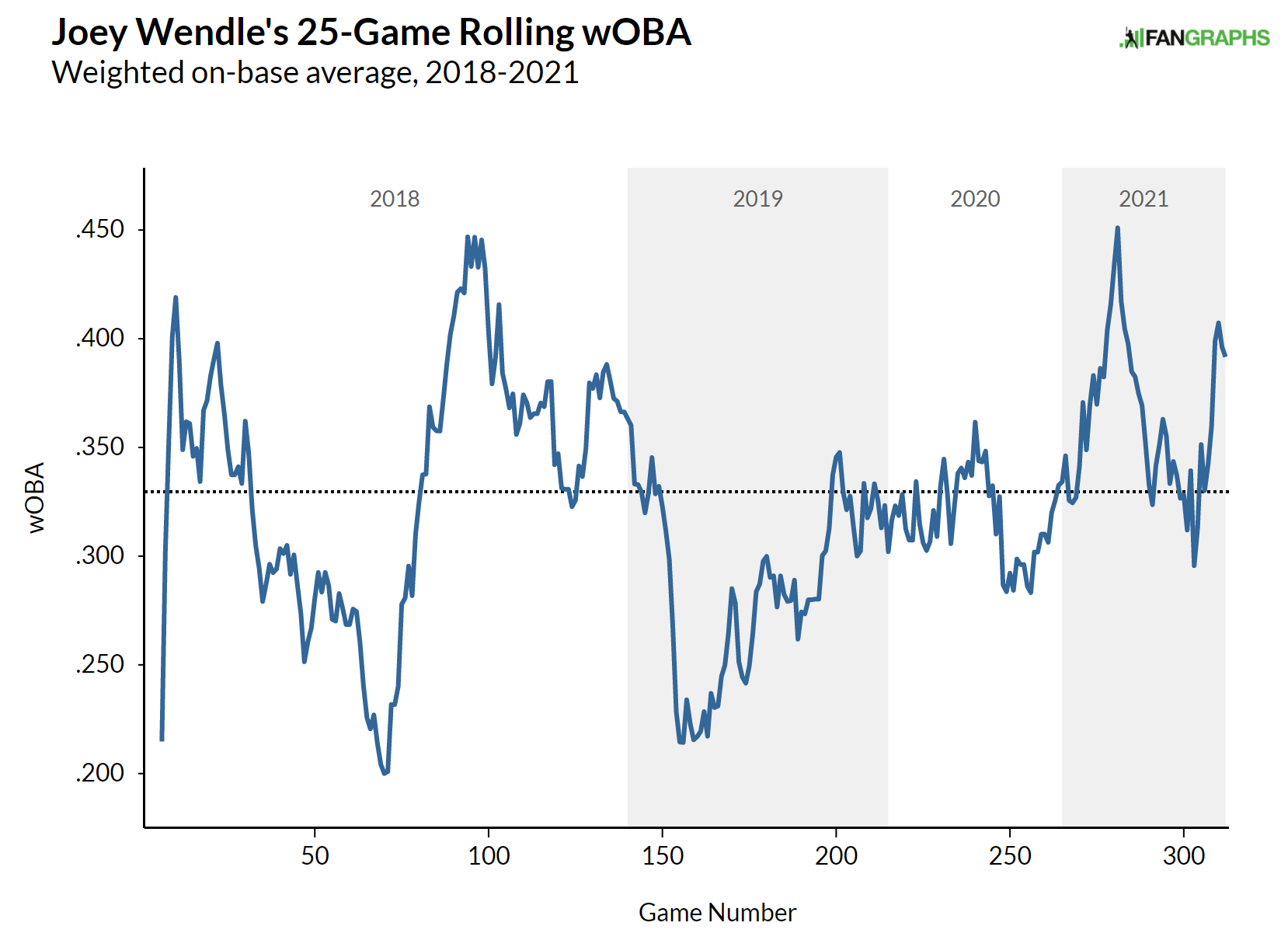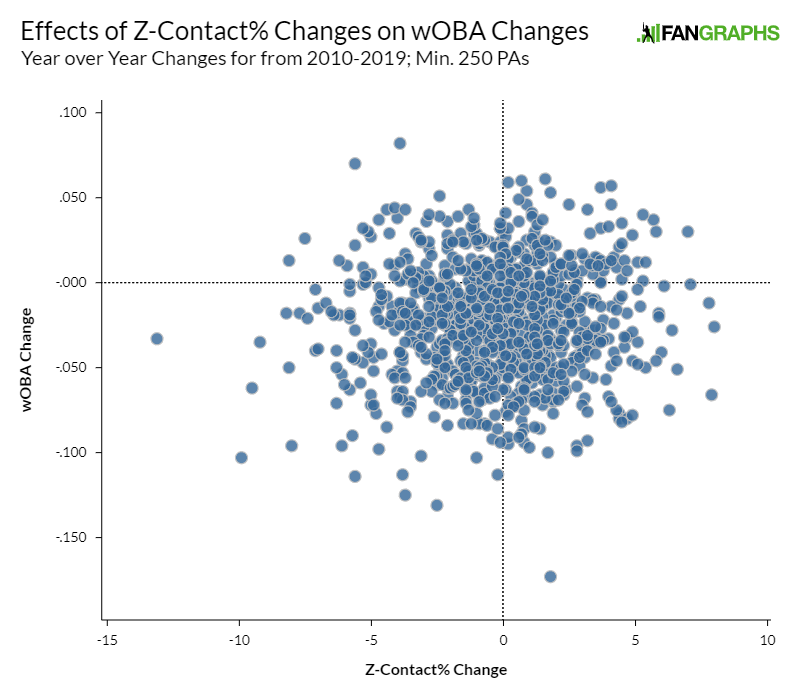Joey Wendle Is Leading the Charge for the White Hot Rays
The Rays have been one of the hottest teams in the majors the past few months and have surged to the top of the American League East standings mostly on the back on the club’s offense. Since May 15, the team has posted a combined 132 wRC+, a figure that would easily lead baseball over this span if it weren’t for the Blue Jays (who boast a 145 wRC+). Given their propensity to not invest in their club’s payroll at levels even close to league average, the Rays often have the feeling of a faceless club. But they do have a few notable position players who you would expect to be leading the charge as they have been blitzing the league.
Without looking, which player is leading the team in WAR? Is it postseason folk-hero Randy Arozarena? What about Austin Meadows or Brandon Lowe who have both led the team in position player WAR in recent seasons? The answer, to my surprise, is utility infielder Joey Wendle with 1.7 WAR.
Wendle was traded to the Rays from the Athletics for a Player To Be Named Later following the 2017 season. In parts of four seasons with the Rays including 2021, Wendle has compiled 7.3 WAR in 1,163 plate appearances, which prorates to about 4.1 WAR per 650 plate appearances (a proxy for a normal season with regular playing time). He is a player who is likely anonymous to the casual fan mostly due to his deployment. As part of the Rays infielder mob, he has only stepped up to the plate on 545, 263, and 184 occasions the past three seasons (note that the 184 PAs came during the pandemic-shortened season). And you never know where to look for him; in his Rays tenure, he has appeared mostly at second and third base but also at shortstop and in left field. One might call him the quintessential Rays player. Wendle is versatile and quietly productive.
Wendle has been a very good player for the Rays throughout his tenure. But the 2021 season has been his best stretch of play since he was brought over.

This season, he’s only had a small stretch below his career line. He has been consistently above his career norm and been more productive than in any stretch of games in 2019 or ’20, Such an exceptional run of play might lead us to wonder whether he had made any meaningful changes to his approach. I emphasize the approach because he has never been a Statcast darling whose performance is driven by hard contact in the air. Per Baseball Savant, he has placed in the lower quartile in both HardHit% and Barrel% the past two seasons, though his barrel rate is up to 5.3% this year, which would represent a career-best mark. That translates to about a .329 xwOBAcon, about 30 points lower than league average. Much of his value (in terms of contact) comes from the frequency with which he puts the ball in play. His collection of balls in play might not be the most eye-popping in terms of the metrics we care about, but the sample is large relative to how often he steps up to the plate. He has consistently been well-above average in terms of strikeout rate (18.1% in a Rays uniform), which is supported by a knack for avoiding swings and misses (an 8.8% SwStr%).
He still is putting the ball in play a lot without much authority. That was and still is the Joey Wendle story since arriving in Florida. So what, if anything, has actually changed?
| Season | Zone % | Zone Swing % | Zone Contact % | Chase % | Chase Contact % | 1st Pitch Swing % | Swing % |
|---|---|---|---|---|---|---|---|
| 2018 | 46.5 | 61.3 | 88.3 | 34 | 64.4 | 23.3 | 46.7 |
| 2019 | 46 | 60.6 | 88.5 | 35.6 | 65.5 | 23.2 | 47.1 |
| 2020 | 48.3 | 64.6 | 91.4 | 36.5 | 62.2 | 23.4 | 50.1 |
| 2021 | 48 | 63.8 | 82.5 | 34.3 | 61.7 | 27.3 | 48.4 |
Wendle’s overall swing rate has been stable across his time in Tampa but his swing decisions are improved. He is chasing pitches less than ever while maintaining some of the gains he made on swings inside the zone last year. Better yet, he is swinging at the first pitch about 17% more this season, though the figure still stands far below the league average figure of 60%. This is not to say that Wendle has great plate discipline. His chase rate is still above the league average by about six percentage points, while his zone swing rate is below the league average by approximately four percentage points. He has a league average overall swing rate but how he gets there leaves a bit to be desired despite his improvements this year.
As I said above, Wendle swings at the first pitch less than half as often as league average despite 52.7% of the 0-0 pitches he sees landing in the strike zone. For context, the league average zone rate is 51.8%, so Wendle is seeing more than the average rate of first pitches in the zone but is swinging substantially less. Swings on these pitches have resulted in a .393 wOBAcon across the majors in 2021 and Wendle himself has crushed first pitches to the tune of a .462 wOBAcon. He has been eminently successful on these pitches yet he refuses to frequently pull the trigger, which indicates there is still some low-hanging fruit for Wendle to pick even with his hot start to the season. Or this could be the product of Wendle feeling more comfortable getting a look at the pitcher before he settles in at the plate. His .462 wOBAcon looks good on the surface, but his xwOBAcon on first pitches is only .226 so he has hardly been stinging the ball around the field on these first pitch swings.
Wendle compensates for his lack of discernment at the plate with elite contact rates. His contact rates in and out of the zone are almost four and nine percentage points above the league average respectively, though the drop in in-zone contact rate is precipitous in 2021. More often than not this has a negative effect on a hitter’s overall line, but the relationship is not as direct as one would think.

Wendle has lost some ability put the ball in play when it is in the strike zone, but that should only be expected to have a small effect on his overall results. The fact that he is making more contact on pitches outside of the zone, which is theoretically more difficult, makes it seem unlikely that he has lost any bat-to-ball skill, but is instead trading off a little bit of contact for power, culminating in the increased barrel rate I mentioned before.
Wendle is primarily a player whose value comes from putting the ball in play. As one might surmise, he does not hit the ball with much authority nor does he display great plate discipline. For Wendle to continue this torrid pace, his results on contact will have to persist. His xwOBA sits at just .295 after MLBAM adjusted its model due to the new ball, which is in line with his figures in the past. In 2018 and ’20, he also posted xwOBA figures of .300, while in 2019 it slightly dipped to .292. Wendle has not really changed much in this regard but he is posting by far the highest wOBA of his career, aided by a .350 BABIP and 14.6% HR/FB rate. Unfortunately for Wendle and the Rays, this suggests that more likely than not, he will now continue to lead the team’s torrid offense. Our Depth Charts projections have him posting a .309 wOBA the rest of the season with his BABIP regressing all the way to .309. But so far, he has been the most productive player for the league’s hottest team. For that, he should be lauded and deserves a tip of the cap as the Rays look to maintain their lead in a tightly contested AL East.
All stats through games on 6/1/2021
Carmen is a part-time contributor to FanGraphs. An engineer by education and trade, he spends too much of his free time thinking about baseball.
The Rays are just so damn interesting. Apart from my own team obviously, they’re the only team in baseball I’ll go out of my way to watch whenever I can